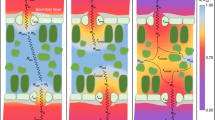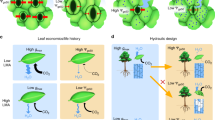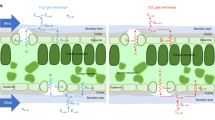Abstract
REPORTS in the literature indicate or suggest that the stomata of succulent plants open in the dark and close in the light. This conclusion is based on direct observations1, measurements of diffusion with a porometer2, and inference3. Nishida2 reported nocturnal stomatal opening in several succulent species, but diurnal opening in others. Thick leaves, few stomata, and small stomatal openings make measurements of the stomatal aperture and subsequent determinations of leaf resistance difficult. The innovation of a resistance hygrometer by Wallihan4 and van Bavel et al.5 allowed the precise determination of leaf resistance to water vapour transfer in succulent plants without the complications frequently encountered with other methods. Measurements of leaf resistance are based on changes in the resistance of a lithium chloride relative humidity sensor as water vapour diffuses from the leaf to the sensor. The sensor is calibrated with standard length tubes placed over a free water surface; thus the leaf resistance can be estimated in meaningful physical units (sec/cm)5. In this communication, we present data indicating the magnitude of leaf resistance to water vapour transfer in Kalanchoe blossfeldiana v. Poelln. in the light and dark. K. blossfeldiana was chosen because many investigators have used it as an experimental plant for dark carbon dioxide fixation studies6,7.
This is a preview of subscription content, access via your institution
Access options
Subscribe to this journal
Receive 51 print issues and online access
$199.00 per year
only $3.90 per issue
Buy this article
- Purchase on Springer Link
- Instant access to full article PDF
Prices may be subject to local taxes which are calculated during checkout
Similar content being viewed by others
References
Shreve, E. B., Physiol. Res., 2, 73 (1916).
Nishida, K., Physiol. Plant., 16, 281 (1963).
Joshi, M. C., Boyer, J. S., and Kramer, P. J., Bot. Gaz., 126, 174 (1965).
Wallihan, E. F., Plant Physiol., 39, 86 (1964).
van Bavel, C. H. M., Nakayama, F. S., and Ehrler, W. L., Plant Physiol., 40, 535 (1965).
Krotkov, G., Runeckles, V. C., and Thimann, K. V., Plant Physiol., 33, 289 (1958).
Gregory, F. G., Spear, I., and Thimann, K. V., Plant Physiol., 29, 220 (1954).
Schwabe, W. W., Nature, 169, 1053 (1952).
Ting, I. P., and Loomis, W. E., Plant Physiol., 40, 220 (1965).
Lee, R., and Gates, D. M., Amer. J. Bot., 51, 963 (1964).
Author information
Authors and Affiliations
Rights and permissions
About this article
Cite this article
TING, I., DEAN, M. & DUGGER, W. Leaf Resistance in Succulent Plants. Nature 213, 526–527 (1967). https://doi.org/10.1038/213526a0
Issue Date:
DOI: https://doi.org/10.1038/213526a0
This article is cited by
Comments
By submitting a comment you agree to abide by our Terms and Community Guidelines. If you find something abusive or that does not comply with our terms or guidelines please flag it as inappropriate.



